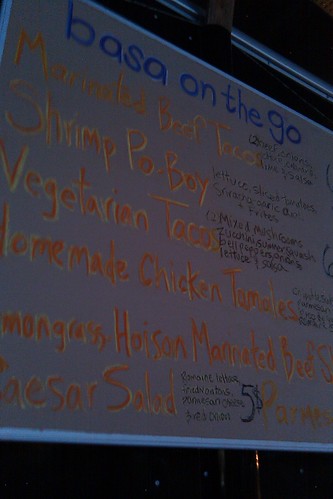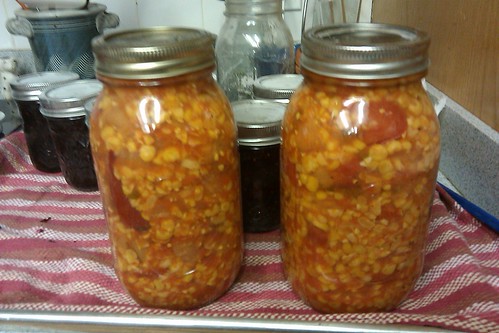
When we decided on a Tribute to the Gulf Coast as a theme for July’s show, I had no idea what to make. I’ve been to the Gulf coast of Florida many times, but that’s not really an area renowned for its culinary tradition (although smoked mullet and hearts of palm, which are illegal to harvest now—the hearts of palm, not the mullet—might be considered a regional dish).
We were thinking New Orleans, Cajun and Creole and all the good things that come from that region.
However, I’ve never been to New Orleans.
My closest authentic experience with Gulf Coast cuisine was about 25 years ago, when I accompanied my then-boyfriend to Alabama to visit his mother.
We’d stop at a stand on the road and buy big bags of freshly caught and boiled crawdads and sit on her balcony, plucking out the plump tail meat and sucking the heads and washing it all down with lots of cold beer.
Our fingers would sting for hours afterwards from the spices. It was a rather magical trip for me and I’ve never forgotten how good those crawdads tasted…
But back to Whitesburg, Kentucky, and WCN!, our radio show.
Although I haven’t been to New Orleans, I’ve eaten plenty of good Cajun foods.
So I started flipping through cookbooks and googling recipes.
The Gulf Coast has been hit hard—we all know that.
The fishing and shrimping industries will have a hard time recovering from the BP disaster.
But even before a drop of oil leaked into the Gulf, the shrimp industry was under attack from another sector—farmed shrimp, mostly from Thailand and other parts of Asia.
These are the shrimp you’re probably eating when you hit the local Applebee’s, and these are the shrimp you’re probably buying at Food City.
They’re cheap—really cheap, comparatively speaking.
And that’s the problem.
Gulf Coast shrimpers can’t compete.
So I was determined to use Gulf Coast shrimp in my recipe.
The only problem was that I didn’t have any.
But my good friend Neil Woods, a pilot who flies out of Hazard, came to my rescue with a pound of shrimp he’d been given in May for filling up his plane with gas in a little Louisiana airport.
I drove up on top of an old strip job to the Wendell Ford Airport and picked up my shrimp.
These were big beauties, with the peels and heads still on.
I wanted to make something to honor that shrimp, somet

hing to highlight it.
And I wondered, as I looked for just the right dish, about the shrimper who caught it in May—is he still in business? Or did the oil spill finish him off?
Would we be eating the last vestiges of somebody’s livelihood, somebody’s culture? I decided to make New Orleans Style Barbequed Shrimp, which is somewhat of a misnomer, because the shrimp never sees a grill.
I looked at a bunch of recipes, and then sort of winged it.
In fact, I’d never made this dish before the show, which was probably a gamble, but it worked.
It was so very good, and so very easy, that I’ll put this dish in regular rotation on my dinner table.
Here’s my attempt at recounting the recipe…
NOLA Style BBQ Shrimp
1 pound of shrimp, preferably Gulf Coast, preferably head-on, unpeeled
4-5 stalks celery
1 large green pepper
1 onion
7-8 cloves of garlic
1 stick of butter (we don’t have to tell you to use real butter, right?
You know that, right?)
A few sprigs of fresh rosemary, enough to yield a couple of tablespoons, once it’s chopped
A handful of fresh parsley, maybe a half-cup chopped
1 beer
A few dashes of Worcestershire sauce
A few sprinklings of your favorite Cajun spice blend—I like Zatarain’s.
Juice of about half a lemon
Salt and cayenne pepper to taste
Start by chopping your holy trinity—the celery, green pepper, and onion—and the garlic. How finely you chop it is up to you—

how fine do you want it when you eat it?
I go for a medium fine chop.
Sauté this mix
in about half of the butter until it’s just starting to brown a bit.
Melt the rest of the butter over the vegetables and season the whole thing with your Cajun spice blend—start with a tablespoon and taste it.
Add more if you need it.
Trust your tongue.
Add salt if you need it (my Cajun blend is salty enough without more salt) and cayenne pepper to taste.
Pour most of a beer (I used about ¾ of a Stella Artois and drank the rest—experiment with other beers, but I don’t think this is the place for a dark beer.
Maybe a blonde beer.
But maybe I’m wrong—try it) and the lemon juice over this mixture and stir well. Place the unpeeled shrimp in a glass baking dish and pour the vegetable/beer mix over it.
Put the whole thing in a preheated 350 degree oven and bake it until the shrimp is just pink—maybe 10-15 minutes, depending on the size of your shrimp.
Do NOT overcook the shrimp!
Check it after 5 minutes and keep checking.
Serve this with lots of crusty bread to soak up the sauce—and of course, lots of cold beer. Note that my ratio of vegetables to shrimp is considerably higher than most recipes for this dish you’

ll find online or in cookbooks.
That’s because I like the vegetables, a lot, and if I’m cooking it, I’m making it the way I like it. And don’t be intimidated by the unpeeled, head-on shrimp.
The peels and heads add an amazing amount of flavor to the finished dish.
A meal like this is meant to be eaten slowly, around a table with good friends and cold beer, as much with your fingers as with any utensil.
Pause to peel the shrimp slowly and to wonder about the shrimper who caught it.
Stop to give thanks for somebody who’ll work so hard for so little that you might have that delectable little shellfish on your plate.
Suck on the head when you’re done—as far as I’m concerned, that’s the best part of this dish.
Experience the myriad layers of flavor and the brininess of the ocean. And say a little prayer for the shrimpers of the Gulf Coast—they’ll need It.
 So it's no secret that I love salt. And I have been blessed with friends who understand how much I love salt. Tonight, as I cooked supper, I realized I have 13 different kinds of salt--8 of them a gift from my dear friend Beth, who lives in a converted whorehouse in Deep Elem in Dallas, TX. And I haven't even called to thank her. For the salt, or for living in an apartment with such a colorful history. Anyway, yesterday, when I made chicken salad, I used the Thai Ginger salt, and it gave it a certain tang.
So it's no secret that I love salt. And I have been blessed with friends who understand how much I love salt. Tonight, as I cooked supper, I realized I have 13 different kinds of salt--8 of them a gift from my dear friend Beth, who lives in a converted whorehouse in Deep Elem in Dallas, TX. And I haven't even called to thank her. For the salt, or for living in an apartment with such a colorful history. Anyway, yesterday, when I made chicken salad, I used the Thai Ginger salt, and it gave it a certain tang. 














 I've been blessed with many obscure talents in this life. I like to think this is the universe's way of making up for my total lack of athletic ability.
I've been blessed with many obscure talents in this life. I like to think this is the universe's way of making up for my total lack of athletic ability.












